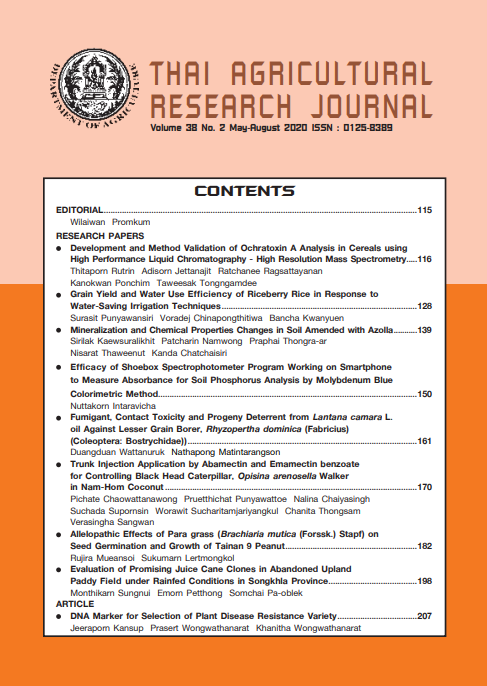Fumigant, Contact Toxicity and Progeny Deterrent from Lantana camara L. oil Against Lesser Grain Borer, Rhyzopertha dominica (Fabricius) (Coleoptera: Bostrychidae)
DOI:
https://doi.org/10.14456/thaidoa-agres.2020.12Keywords:
fumigant, contact, progeny deterrent, Lantana camara L., lesser grain borerAbstract
Efficacy of essential oil from Lantana camara L. as the fumigant, contact toxicity and progeny deterrent were tested against lesser grain borer, Rhyzopertha dominica (Fabricius). Concentrations of essential oil from L. camara at 0, 20, 40, 60, 80 and 100 μμl/ml were applied with 5 replications. The experiment was conducted at biology laboratory under 25-27°oC and 75-80% RH conditions. Results showed that the fumigant, contact toxicity and progeny deterrent of essential oil from L. camara on the lesser grain borer were effective when compared with control. At concentration of 100μ μl/ml, using it as fumigant gave 70% mortality with the LC50 value of 76.45μ μl/ml at 24 h, while the contact toxicity gave 94% mortality with the LC50 value of 50.00μ μl/ml at 24 h. For progeny deterrent effects, using the same concentration of essential oil and starting from 5 pairs of parent, the number of derived progeny was 1.80 ± 0.74 adults, percentage of progeny deterrent was 94.11 and the time of development was 54.40 ± 1.62 days. Whereas in control, the number of progeny was 30.60 ± 2.55 adults, percentage of progeny deterrent was 0.0% and the time of development was 28.60 ± 3.35 days.
References
เพ็งคุ้ม และจิราภรณ์ ทองพันธ์. 2548. แมลงศัตรูข้าวเปลือกและการป้องกันกำจัด. เอกสารวิชาการ. สำนักวิจัยและพัฒนาวิทยาการหลังการเก็บเกี่ยวและแปรรูปผลผลิตทางการเกษตร กรมวิชาการเกษตร, กรุงเทพฯ. 160 หน้า.
Abbott, W.S. 1925. Method of computing the effectiveness of an insecticide. J. Econ. Entomol.
18(2): 265-267.
Afful, E., B. Elliott, M.K. Nayak and T.W. Phillips. 2018. Phosphine resistance in North American
field populations of the lesser grain borer, Rhyzopertha dominica (Coleoptera: Bostrichidae). J. Econ. Entomol. 111(1): 463–469.
Ahmad, A., M. Ahmed, Noorullah, Q.M. Ali, M. Abbas and S. Arif. 2013. Monitoring of resistance
against phosphine in stored grain insect pests in Sindh. MEJSR. 16 (11): 1501-1507.
Arthur, F.H., G.O. Ondier and T.J. Siebenmorgen. 2012. Impact of Rhyzopertha dominica (F.) on
quality parameters of milled rice. J. Stored Prod Res. 48: 137-142.
Aulicky, R. and V. Stejskal. 2015. Efficacy and limitations of phosphine “spot-fumigation” against
five Coleoptera species of stored product pests in wheat in a grain store – short note.
Plant Protect. Sci. 51: 33–38.
Brari, F. and D.R. Thakur. 2017. Bioefficacy of four essential oils against Callosobruchus analis (F.)
(Coleoptera: Bruchidae), A seed pest of stored legumes worldwide. IJER. 2(6): 71-75.
Dey, K.R., P. Choudhury and B.K. Dutta. 2013, Impact of pesticide use on the health of farmers: A
study in Barak Valley, Assam (India). J Environ Chem Ecotoxicol, 5: 269-277.
El-Wakeil, N.E. 2013. Botanical pesticides and their mode of action. Gesunde Pflanzen. 65: 125–
149.
Guo, S., W. Zhang, J. Liang, C. You, Z. Geng, C. Wang and S. Du. 2016. Contact and repellent
activities of the essential oil from Juniperus formosana against two stored product insects. Molecules. 21: 1-11.
Isman, M.B. 2006. Botanical insecticides, detrrents, and repellents in modern agriculture and an
increasingly regulated world. Annu. Rev. 51: 45–66.
Isenring, R. 2010. Pesticides reduce biodiversity. Pesticides news. 88, 4-7.
Koul, O., S. Walia and G.S. Dhaliwai. 2008. Essential oils as green pesticides: potential and
constraints. Biopesticides Int. 4(1), 63–84.
Murugesan, S., C. Rajeshkannan, D.S. Babu, R. Sumathi and P. Manivachakam. 2012. Identification
of insecticidal properties in common weed - Lantana camara Linn by gas chromatography and mass spectrum (GC-MS-MS). Adv. Appl. Sci. Res. 3(5): 2754-2759.
Pimentel, M.A.G., L.A.D. Faroni, M.D. Batista and F.H. da Silva. 2008. Resistance of stored-product
insects to phosphine. Pesq. agropec. bras. Brasília. 43(12): 1671-1676.
Pires, E.M. and R.M. Nogueira. 2018. Damage caused by Rhyzopertha dominica (Fabricius, 1792)
(Coleoptera: Bostrichidae) in stored Brazil nuts. Sci. Elec. Arch. 11(1): 57-61.
Priyanka, N and P.K. Joshi. 2013. A review of Lantana camara studies in India. IJSRP. 3(10): 1-11.
Rajashekar, Y., K.V. Ravindra and N. Bakthavatsalam. Leaves of Lantana camara Linn.
(Verbenaceae) as a potential insecticide for the management of three species of stored grain insect pests. J Food Sci Technol. 51(11): 3494–3499.
Rani, P.U. 2012. Fumigant and contact toxic potential of essential oils from plant extracts against
stored product pests. JBiopest. 5(2): 120-128.
Relyea, R.A. 2005. The impact of insecticide and herbicide on the biodiversity and productivity
of aquatic communities. Ecol. Appl. 15(2): 618–627.
Sharma, G.P., A.S. Raghubanshi and J.S. Singh. 2005. Lantana invasion: An overview. Weed
Bio and Manage. 5: 157–165.
Srivastava, C. and S. Subramanian. 2016. Storage insect pests and their damage symptoms: an
overview. J. of Grain Storage Res. 11: 53-58.
Tripath, S. Upadhyay, M. Bhuiyan and P.R. Bhattacharya. 2009. A review on prospects of
essential oils as biopesticide in insect-pest management. Journal of Pharmacognosy
and Phytotherapy. 1(5): 1-13.
Downloads
Published
How to Cite
Issue
Section
License
Copyright (c) 2020 Thai Agricultural Research Journal

This work is licensed under a Creative Commons Attribution-NonCommercial-NoDerivatives 4.0 International License.
Thai Agricultural Research Journal



